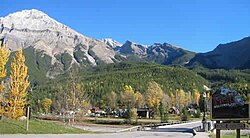Field, British Columbia
Contributors to Wikimedia projects
 Article Images
Article Images
Field is an unincorporated community of approximately 169 people located in the Kicking Horse River valley of southeastern British Columbia, Canada, within the confines of Yoho National Park. At an elevation of 1,256 m (4,121 ft), it is 27 km (17 mi) west of Lake Louise along the Trans-Canada Highway, which provides the only road access to the town. The community is named for Cyrus West Field of Transatlantic telegraph cable fame, who visited the area in 1884.[2]: 81
Field | |
|---|---|
Unincorporated | |
 Front entrance to the townsite | |
| Coordinates: 51°23′45″N 116°29′20″W / 51.39583°N 116.48889°W | |
| Country | Canada |
| Province | British Columbia |
| Regional district | Columbia-Shuswap |
| Named for | Cyrus West Field |
| Population (2011)[1] | |
| • Total | 195 |
| Time zone | UTC−7 (Mountain Standard Time (MST)) |
| • Summer (DST) | UTC−6 (MDT) |
| Postal code | V0A 1G0 |


In 2011, Field had a population of 195 year-round residents.[1]
Townsite administration
Field's land ownership was split between the Crown and the Canadian Pacific Railway (CPR), with the border between the two jurisdictions being Stephen Avenue. The railway was in charge of the water and electricity supply for the town until the 1950s, when the Canadian government took over. Today, the townsite is managed by Parks Canada. Local residents lease their land from the park administration, with a term of 42 years.
CPR track workers in Field discovered the fossils of the Burgess Shale. Commonly called by the workers "the stone bugs", the first fossils were discovered on Mount Stephen.[3] In 1909, Charles D. Walcott discovered the Walcott Quarry on the slope of Mount Field.
- ^ a b "Evaluation of Parks Canada's Townsite Management Sub-Program" (PDF). Parks Canada. January 11, 2017. p. 47. Retrieved April 16, 2020.
- ^ Akrigg, G.P.V.; Akrigg, Helen B. (1986), British Columbia Place Names (3rd, 1997 ed.), Vancouver: UBC Press, ISBN 0-7748-0636-2
- ^ Richard McConnell, of the Geological Survey of Canada, was mapping the geology around the railway in September 1886 and was pointed to the Mount Stephen trilobite beds by a construction worker. Source: Collins, D. (Aug 2009). "Misadventures in the Burgess Shale". Nature 460 (7258): 952. doi:10.1038/460952a. ISSN 0028-0836. PMID 19693066.
- Field travel guide from Wikivoyage
- Field.ca - Information for people traveling to Field and Yoho National Park
- Fieldbc.ca - Community website and history of the town
- Friends of Yoho - The Friends of Yoho National Park Society promote appreciation, understanding and stewardship of the ecology and culture of Yoho National Park
- BC Archives Photo: Mount Stephen Hotel and CPR Station in Field, 1905
